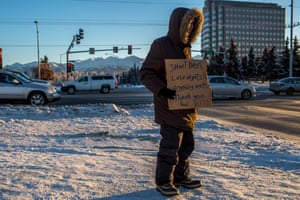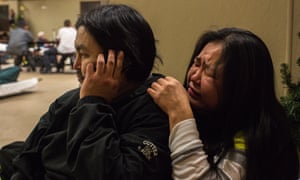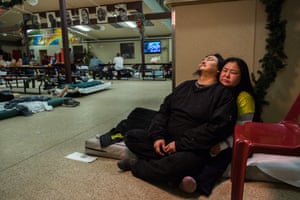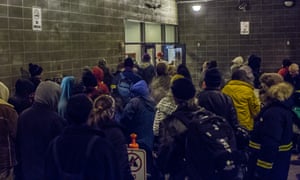Extract from The Guardian
Alaska has some of the highest per capita rates of homelessness and alcoholism in America – and as the temperature drops, the number of homeless deaths risesby Julia O'Malley in Anchorage, Alaska
Saturday 24 December 2016 23.00 AEDT
As soon as she glimpsed at the body on the icy street, Marie Nickolai knew it was Jackie Amaktoolik. He’d been drinking outside. People said he had collapsed.
She wept as friends coaxed her from the scene. “That’s my brother,” she said.
When homeless people die in Alaska, it is often like this: outside, facilitated by a lethal combination of alcohol and cold.
Nickolai’s stepbrother, known on the streets as Isaac, died on 13 December. The temperature was 6F (-14C).
Nickolai, 42, and her stepbrother grew up among eight siblings in the remote Yupik village of New Stuyahok along the Nushagak river in western Alaska. She said it was a childhood of picking berries, hunting moose, fishing and attending the Russian Orthodox church.
However, for years in their adulthood, Nickolai and Amaktoolik lived on the streets of Anchorage, Alaska’s largest city. Both lived with chronic alcoholism.
Carl, a 28-year-old who has been homeless for most of his life, holds a sign on a corner in Anchorage, when the temperature remained in the single digits. Photograph: Ash Adams for the Guardian
Alaska has some of the highest per capita rates of homelessness and alcoholism in America. From October to April, when temperatures can fall below freezing in this city of 300,000, bodies turn up outside with grim predictability; they are found in cars, hunched for warmth near transformer boxes, or in makeshift camps in the city’s many wooded parks.
Bodies also appear in the spring, as the snow recedes, often surrounded by plastic bottles once filled with alcohol or mouthwash. The most at-risk are those who have poorly treated physical or mental illnesses and years of alcoholism. The dead are disproportionately Alaska Natives, police and homelessness advocates say, who make up 20% of the general population but constitute half of the clients in shelters.
There are about 3,000 to 4,000 people without permanent housing in Anchorage, though many of those are living in shelters or couch surfing. At the last count in August, about 450 people were living in emergency shelters and in outside camps.
Each winter, the city scrambles to find enough shelter beds to prevent deaths from exposure. Almost always, the demand is greater than the supply. At times during November, Brother Francis, the city’s largest shelter, turned away 50 people a night, said Lisa Caldeira, its program director.
The city was able to open more than 100 extra beds in early December, but Brother Francis is still turning people away. “It’s not enough,” Caldeira said.
Kim Kovol, deputy director of the city’s largest soup kitchen, Bean’s Cafe, said her staff walk the streets every morning this time of year in search of people who need help. “Our staff go out and wake everybody,” she said. “All you do is pray they are not dead.”
Our staff go out and
wake everybody. All you do is pray they are not dead
Kim Kovol, director of Anchorage's largest soup kitchenWhen someone begins drinking in the cold, they may have a false sense of warmth. Continued drinking slows circulation in the extremities, doctors say, which can lead to frostbite. It also causes dehydration, exacerbating the symptoms of hypothermia, including poor reasoning and drowsiness.
“People pass out,” Kovol said. “They pass out on the street, in the sidewalk, in parking lots.”
Nancy Burke, housing and homeless coordinator for Anchorage, said the drug of choice in the city is alcohol. The rate of alcohol abuse among Alaska Natives is consistently the highest among all ethnic groups, mirroring that of American Indians in the lower 48 states, according to federal statistics.
Marie Nickolai sobs while her partner, Steven Moses, tells family members about Isaac’s death. Photograph: Ash Adams for the Guardian
Nickolai said she moved from her village with a man who had a home and a job in the city. When their relationship ended, he dropped her off at the shelter. That was seven years ago, she said. Her stepbrother, Amaktoolik, had been in and out of jail since at least 2012, related to a charge of sexual abuse of a minor, according to court records.
When Nickolai sleeps outside in winter, she said, she does so because the shelter is crowded, or she wants to drink or sleep next to her partner, Steven Moses, 37. (Shelters in Anchorage prohibit alcohol and they separate couples.)
To stay warm, Nickolai and Moses find an out-of-the-way spot, lay cardboard on the ground and cover it with blankets. The body heat from a partner can increase the chances of survival, but sleeping outside is still perilous.
“I have family members who did not wake up,” Moses said. “I pray … dear lord, dear creator, watch over us.”
Moses said he recently had a close call. He suffered seizures on a downtown street – prompted, he said, by symptoms associated with alcohol withdrawal. A stranger saw him, removed his backpack and performed CPR.
Steve Moses and Marie Nickolai sit on a mattress in Bean’s Cafe. Photograph: Ash Adams for the Guardian
“I came to, I said: I’m here, I’m here, I’m back,” he recalled. “He was there, standing over me, he said: ‘Are you OK?’ I said: ‘Yeah, I’m OK.’ By then I could see the red and white lights in my periphery.”
Caldeira, the program director at the Brother Francis Shelter, said additional winter shelter beds are a stopgap measure. The city cannot rely on them to permanently solve the problem of homelessness. Instead, there must be more supportive permanent housing, she argued, a “housing-first” model that allows people to live there even if they are unable to quit drinking.
A model used in Seattle and Salt Lake City, advocates say it has shown to provide the stability required to reduce drinking and other harmful behavior. There is also evidence that prioritizing permanent housing lowers the overall cost of homelessness to the public, such as by reducing emergency room visits and calls to police.
“Housing first is going to be the only solution for a number of people,” Caldeira said.
The city has 120 housing-first beds, but the challenge of locating larger housing projects for homeless people is that neighborhoods resist them. Even so, the city’s newly elected mayor, Ethan Berkowitz, has said he would like to add 100 beds for each of the three years he is in office.
With tight shelter space, some take dangerous risks to secure a bed. Some homeless people, for example, say they will drink in the street until they are seriously intoxicated, in the hope of being picked up by police or a public service van that can take them to a warm sleep-off shelter. Police report they routinely see people who have two or three times the blood alcohol limit for driving. Nickolai has done that before, she said.
People wait in the nightly line to get into Brother Francis, the largest homeless shelter in Anchorage. Photograph: Ash Adams for the Guardian
“I get up in the morning: ‘Where am I?’” Nickolai said.
Hours after her stepbrother died, Nickolai and her boyfriend found beds at Bean’s Cafe, which has recently begun offering nighttime shelter. Her phone rang with calls from relatives from her village, but she couldn’t bring herself to relay the news.
Instead, she prayed for her brother, repeating a Yup’ik word. “It means ‘You can see, you can breathe, no more nothing can bother you’,” she said.
The last time Nickolai spoke to Amaktoolik, who was 62, he had been drinking outside with friends. “He told me he was going to buy a half-gallon,” she said. “I said OK, just take care of yourself.”
She wishes she could quit drinking. She would need medical supervision to withdraw, she said, and then treatment. “It’s a disease of alcohol and I want to get away from it,” she said.
Nickolai considered going home to the village where she had family and a place to stay. Maybe it would be easier to be sober there. But getting there – a 300-mile journey, by small plane – would cost $1,000 in airfare for both her and Moses.
They said they do not have that kind of money.
As Nickolai spoke, a bottle of Rich & Royal whisky that had been hidden under her blankets slid into view. A shelter employee saw it and asked Nickolai and Moses to leave.
In the parking lot outside, holding her crumpled bedding, Nickolai yelled and cursed. She and Moses trudged toward the bus stop. They could ride a couple more hours to stay warm. Then they would need to find a place to sleep.




No comments:
Post a Comment